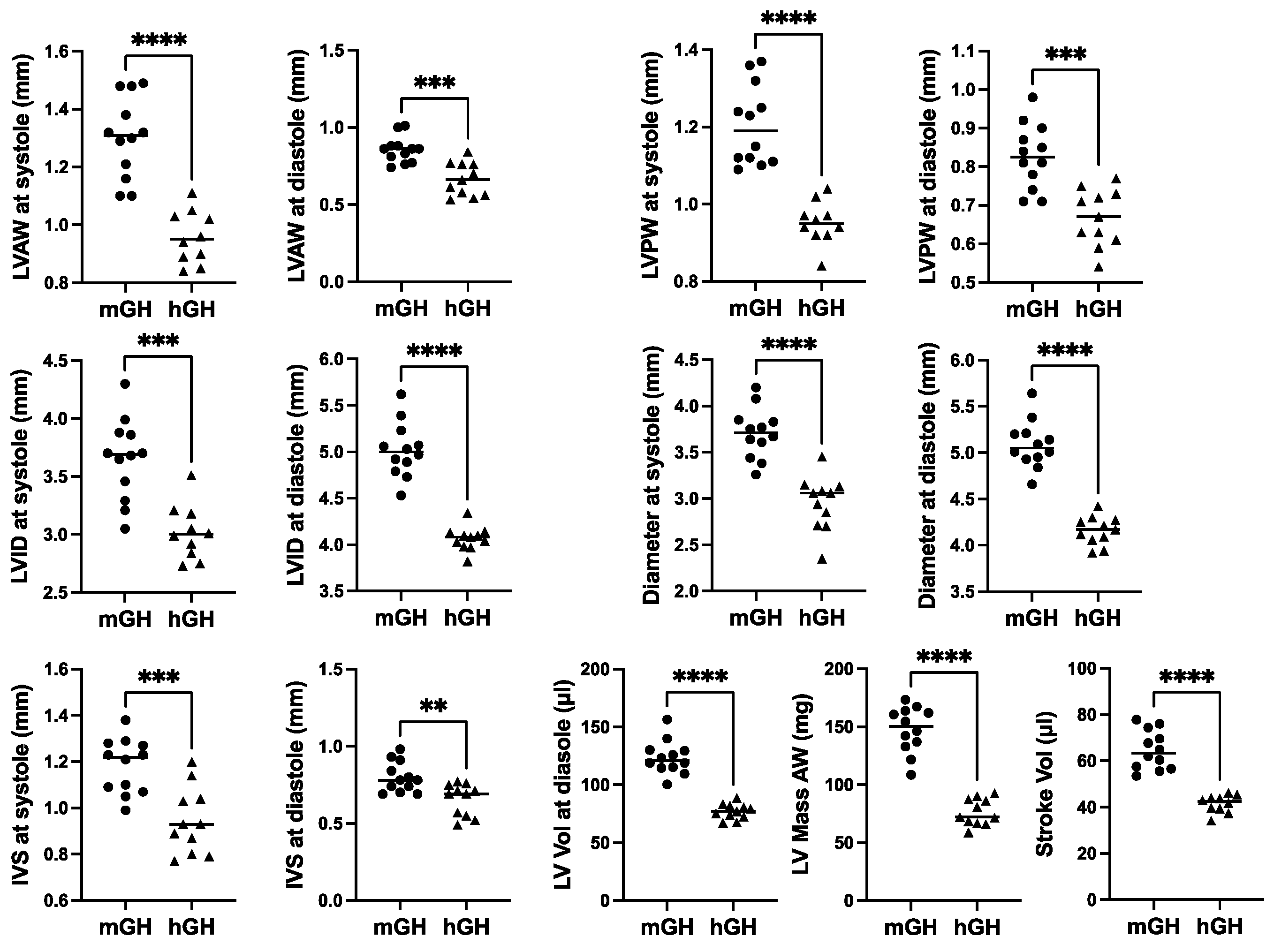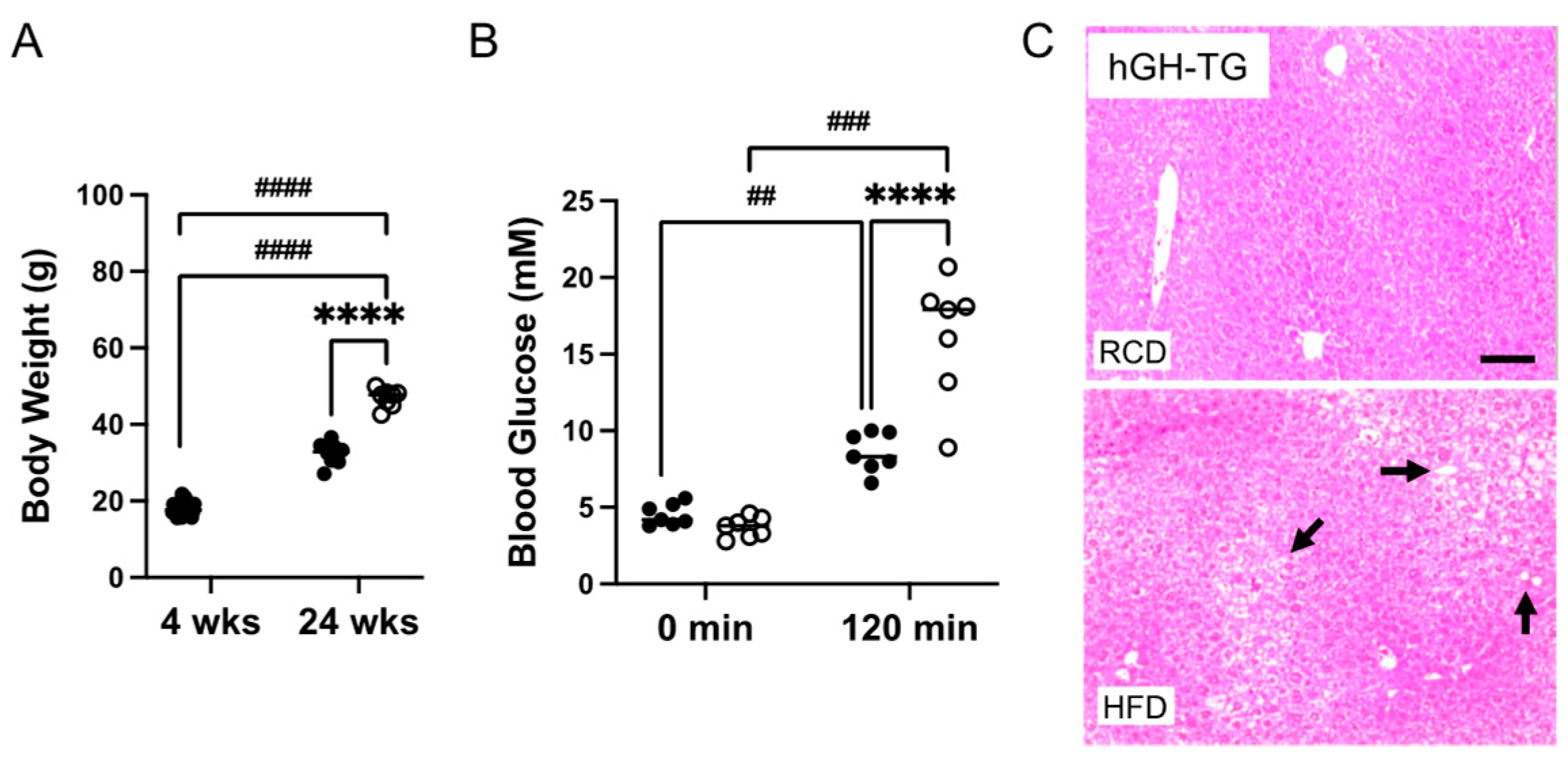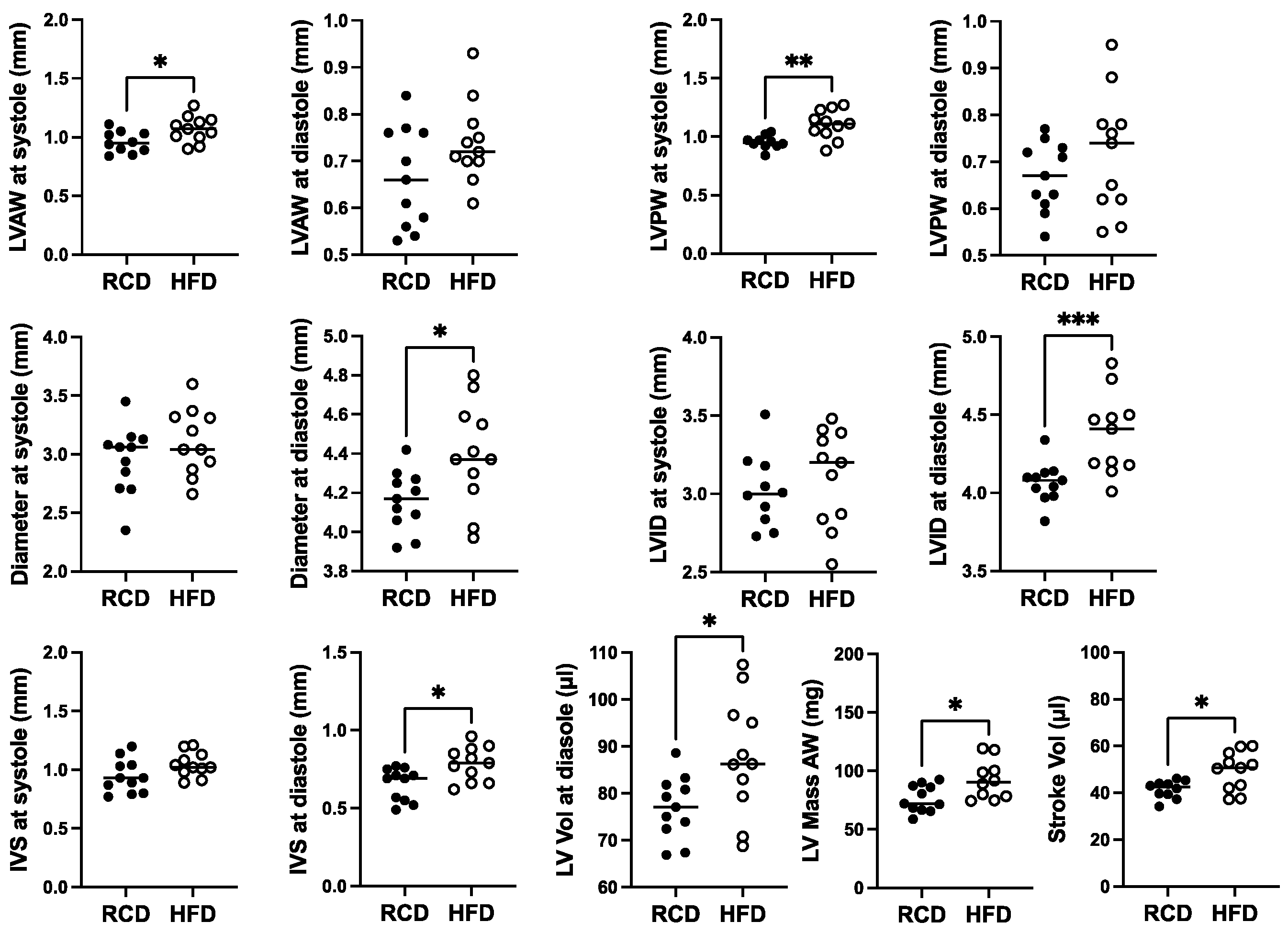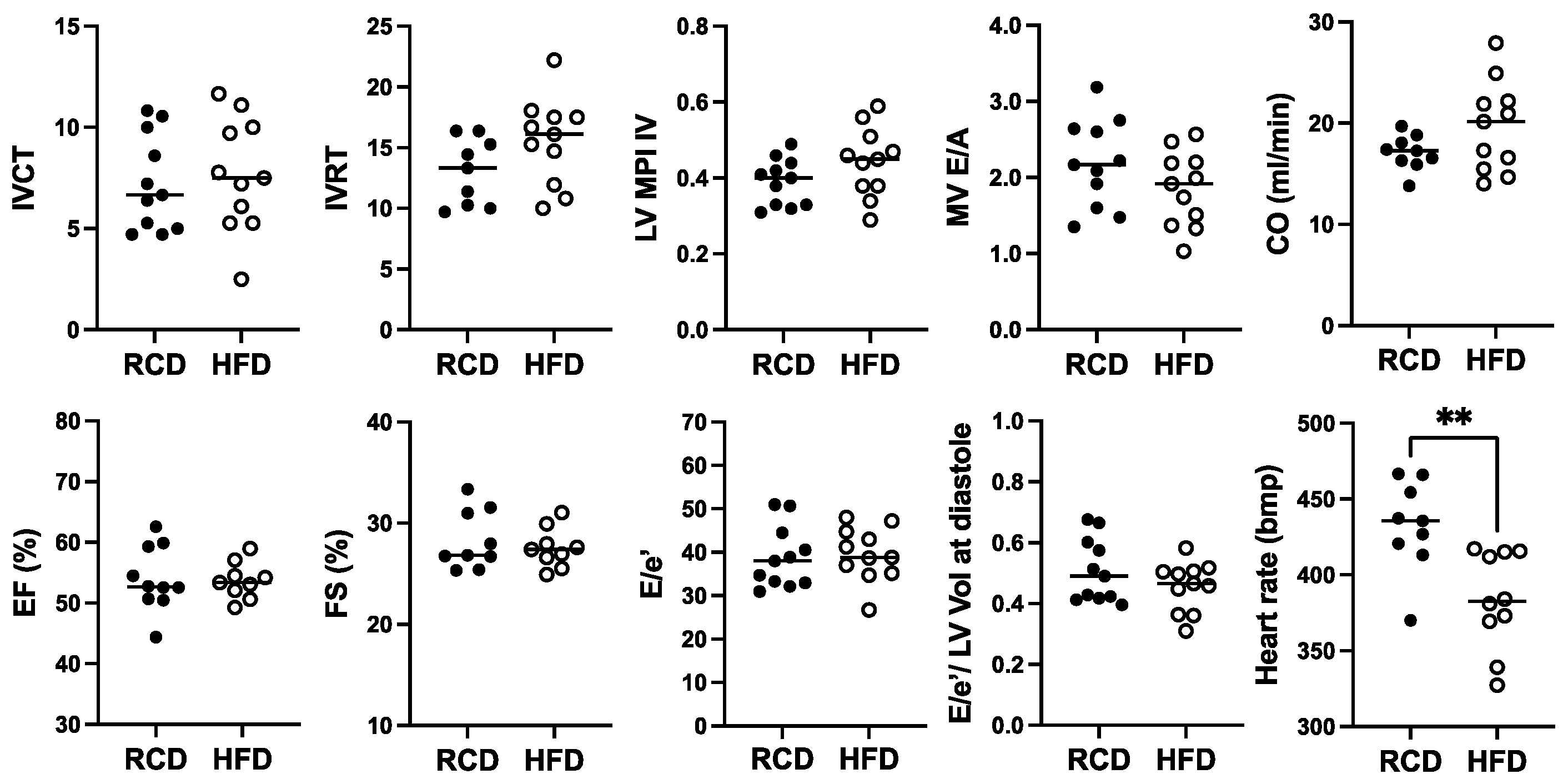Diastolic Dysfunction with Normal Ejection Fraction and Reduced Heart Rate in Mice Expressing Human Growth Hormone and Displaying Signs of Growth Hormone Insufficiency
Abstract
:1. Introduction
2. Results
2.1. Comparison of Male hGH-TG and mGH-WT CD-1 Mouse Body and Heart Weight
2.2. Comparison of Cardiac Structure and Function in 28-Week-Old Male hGH-TG and mGH-WT CD-1 Mice by Echocardiography
2.3. Effect of HFD on the Heart in hGH-TG Mice Showing Signs of Insulin Resistance
2.4. Effect of Chronic HFD on RNA Levels for Markers Linked to Cardiac Damage
3. Discussion
4. Materials and Methods
4.1. Mice and Diet
4.2. Glucose Tolerance Test (GTT)
4.3. Echocardiography
4.4. Real-Time Reverse Transcriptase-Polymerase Chain Reaction (PCR)
4.5. Statistical Analysis
Author Contributions
Funding
Institutional Review Board Statement
Informed Consent Statement
Data Availability Statement
Acknowledgments
Conflicts of Interest
References
- Sacca, L.; Cittadini, A.; Fazio, S. Growth hormone and the heart. Endocr. Rev. 1994, 15, 555–573. [Google Scholar] [CrossRef] [PubMed]
- Ren, J.; Samson, W.K.; Sowers, J.R. Insulin-like growth factor I as a cardiac hormone: Physiological and pathophysiological implications in heart disease. J. Mol. Cell Cardiol. 1999, 31, 2049–2061. [Google Scholar] [CrossRef]
- Isgaard, J.; Arcopinto, M.; Karason, K.; Cittadini, A. GH and the cardiovascular system: An update on a topic at heart. Endocrine 2015, 48, 25–35. [Google Scholar] [CrossRef] [PubMed]
- Castellano, G.; Affuso, F.; Conza, P.D.; Fazio, S. The GH/IGF-1 Axis and Heart Failure. Curr. Cardiol. Rev. 2009, 5, 203–215. [Google Scholar] [CrossRef]
- Macvanin, M.; Gluvic, Z.; Radovanovic, J.; Essack, M.; Gao, X.; Isenovic, E.R. New insights on the cardiovascular effects of IGF-1. Front. Endocrinol. 2023, 14, 1142644. [Google Scholar] [CrossRef] [PubMed]
- Lombardi, G.; Di Somma, C.; Grasso, L.F.; Savanelli, M.C.; Colao, A.; Pivonello, R. The cardiovascular system in growth hormone excess and growth hormone deficiency. J. Endocrinol. Investig. 2012, 35, 1021–1029. [Google Scholar]
- Caicedo, D.; Diaz, O.; Devesa, P.; Devesa, J. Growth Hormone (GH) and Cardiovascular System. Int. J. Mol. Sci. 2018, 19, 290. [Google Scholar] [CrossRef] [PubMed]
- Jara, A.; Liu, X.; Sim, D.; Benner, C.M.; Duran-Ortiz, S.; Qian, Y.; List, E.O.; Berryman, D.E.; Kim, J.K.; Kopchick, J.J. Cardiac-Specific Disruption of GH Receptor Alters Glucose Homeostasis While Maintaining Normal Cardiac Performance in Adult Male Mice. Endocrinology 2016, 157, 1929–1941. [Google Scholar] [CrossRef]
- Bartke, A.; Kopchick, J.J. The forgotten lactogenic activity of growth hormone: Important implications for rodent studies. Endocrinology 2015, 156, 1620–1622. [Google Scholar] [CrossRef]
- Cattini, P.A.; Bock, M.E.; Jin, Y.; Zanghi, J.A.; Vakili, H. A useful model to compare human and mouse growth hormone gene chromosomal structure, expression and regulation, and immune tolerance of human growth hormone analogues. Growth Horm. IGF Res. 2018, 42–43, 58–65. [Google Scholar] [CrossRef]
- Bole-Feysot, C.; Goffin, V.; Edery, M.; Binart, N.; Kelly, P.A. Prolactin (PRL) and its receptor: Actions, signal transduction pathways and phenotypes observed in PRL receptor knockout mice. Endocr. Rev. 1998, 19, 225–268. [Google Scholar]
- Ouhtit, A.; Morel, G.; Kelly, P.A. Visualization of gene expression of short and long forms of prolactin receptor in the rat. Endocrinology 1993, 133, 135–144. [Google Scholar] [CrossRef] [PubMed]
- Howarth, F.C.; Norstedt, G.; Boldyriev, O.I.; Qureshi, M.A.; Mohamed, O.; Parekh, K.; Venkataraman, B.; Subramanya, S.; Shmygol, A.; Al Kury, L.T. Effects of prolactin on ventricular myocyte shortening and calcium transport in the streptozotocin-induced diabetic rat. Heliyon 2020, 6, e03797. [Google Scholar] [CrossRef]
- Papazoglou, A.S.; Leite, A.R. Prolactin levels and cardiovascular disease: A complicate relationship or a confounding association? Eur. J. Prev. Cardiol. 2023, zwad176. [Google Scholar]
- Pirchio, R.; Graziadio, C.; Colao, A.; Pivonello, R.; Auriemma, R.S. Metabolic effects of prolactin. Front. Endocrinol. 2022, 13, 1015520. [Google Scholar]
- Jin, Y.; Jarmasz, J.S.; Sultana, S.; Cordero-Monroy, L.; Taylor, C.G.; Zahradka, P.; Kardami, E.; Cattini, P.A. Increased capacity to maintain glucose homeostasis in a transgenic mouse expressing human but not mouse growth hormone with developing high-fat diet-related insulin resistance, hepatic steatosis and adipose dysfunction. J. Mol. Endocrinol. 2024, 1, 73. [Google Scholar] [CrossRef] [PubMed]
- Tuttle, A.H.; Philip, V.M.; Chesler, E.J.; Mogil, J.S. Comparing phenotypic variation between inbred and outbred mice. Nat. Methods 2018, 15, 994–996. [Google Scholar] [CrossRef]
- Aldinger, K.A.; Sokoloff, G.; Rosenberg, D.M.; Palmer, A.A.; Millen, K.J. Genetic variation and population substructure in outbred CD-1 mice: Implications for genome-wide association studies. PLoS ONE 2009, 4, e4729. [Google Scholar] [CrossRef] [PubMed]
- Sergeeva, I.A.; Christoffels, V.M. Regulation of expression of atrial and brain natriuretic peptide, biomarkers for heart development and disease. Biochim. Biophys. Acta 2013, 1832, 2403–2413. [Google Scholar] [CrossRef] [PubMed]
- Sahu, S.P.; Liu, Q.; Prasad, A.; Hasan, S.M.A.; Liu, Q.; Rodriguez, M.X.B.; Mukhopadhyay, O.; Burk, D.; Francis, J.; Mukhopadhyay, S.; et al. Characterization of fibrillar collagen isoforms in infarcted mouse hearts using second harmonic generation imaging. Biomed. Opt. Express 2021, 12, 604–618. [Google Scholar] [CrossRef]
- Li, T.T.; Li, X.Y.; Jia, L.X.; Zhang, J.; Zhang, W.M.; Li, Y.L.; Qi, Y.F.; Du, J. Whole Transcriptome Analysis of Hypertension Induced Cardiac Injury Using Deep Sequencing. Cell Physiol. Biochem. 2016, 38, 670–682. [Google Scholar] [CrossRef] [PubMed]
- Kopchick, J.J.; Berryman, D.E.; Puri, V.; Lee, K.Y.; Jorgensen, J.O.L. The effects of growth hormone on adipose tissue: Old observations, new mechanisms. Nat. Rev. Endocrinol. 2020, 16, 135–146. [Google Scholar] [CrossRef]
- Cittadini, A.; Cuocolo, A.; Merola, B.; Fazio, S.; Sabatini, D.; Nicolai, E.; Colao, A.; Longobardi, S.; Lombardi, G.; Sacca, L. Impaired cardiac performance in GH-deficient adults and its improvement after GH replacement. Am. J. Physiol. 1994, 267, E219–E225. [Google Scholar] [CrossRef] [PubMed]
- Mottram, P.M.; Marwick, T.H. Assessment of diastolic function: What the general cardiologist needs to know. Heart 2005, 91, 681–695. [Google Scholar] [CrossRef] [PubMed]
- Ommen, S.R.; Nishimura, R.A.; Appleton, C.P.; Miller, F.A.; Oh, J.K.; Redfield, M.M.; Tajik, A.J. Clinical utility of Doppler echocardiography and tissue Doppler imaging in the estimation of left ventricular filling pressures: A comparative simultaneous Doppler-catheterization study. Circulation 2000, 102, 1788–1794. [Google Scholar] [CrossRef] [PubMed]
- Schnelle, M.; Catibog, N.; Zhang, M.; Nabeebaccus, A.A.; Anderson, G.; Richards, D.A.; Sawyer, G.; Zhang, X.; Toischer, K.; Hasenfuss, G.; et al. Echocardiographic evaluation of diastolic function in mouse models of heart disease. J. Mol. Cell Cardiol. 2018, 114, 20–28. [Google Scholar] [CrossRef]
- Claessens, P.J.; Claessens, C.W.; Claessens, M.M.; Claessens, M.C.; Claessens, J.E. Supernormal left ventricular diastolic function in triathletes. Tex. Heart Inst. J. 2001, 28, 102–110. [Google Scholar]
- Chen, H.; Jungesblut, J.; Saering, D.; Muellerleile, K.; Beitzen-Heineke, A.; Harms, P.; Erley, J.; Schoennagel, B.; Schneider, J.N.; Cavus, E.; et al. Left ventricular diastolic filling patterns in competitive triathletes with and without myocardial fibrosis by cardiac magnetic resonance time-volume analysis. Eur. J. Radiol. 2023, 158, 110615. [Google Scholar] [CrossRef] [PubMed]
- Zhang, N.; Tang, L.; Zhang, L.; Wang, Q.; Zhao, L.; Liu, X.; Hua, Y.; Duan, H.; Shao, S.; Zhou, K.; et al. Evaluation of left ventricular stiffness with echocardiography. Echocardiography 2024, 41, e15737. [Google Scholar] [CrossRef] [PubMed]
- Ngiam, J.N.; Chew, N.W.; Tan, B.Y.; Sim, H.W.; Kong, W.K.F.; Yeo, T.C.; Chowdhury, S.M.; Poh, K.K. Novel Echocardiography-Derived Left Ventricular Stiffness Index in Low-Flow Versus Normal-Flow Severe Aortic Stenosis with Preserved Left Ventricular Ejection Fraction. Sci. Rep. 2020, 10, 9086. [Google Scholar] [CrossRef]
- Vinhas, M.; Araujo, A.C.; Ribeiro, S.; Rosario, L.B.; Belo, J.A. Transthoracic echocardiography reference values in juvenile and adult 129/Sv mice. Cardiovasc. Ultrasound 2013, 11, 12. [Google Scholar] [CrossRef] [PubMed]
- Tas, S.; Tas, U.; Ozpelit, E.; Edem, E.; Akdeniz, B. Effect of Heart Rate-Oriented Therapy on Diastolic Functions in Patients with Heart Failure with Reduced Ejection Fraction. Acta Cardiol. Sin. 2018, 34, 251–258. [Google Scholar] [PubMed]
- Zile, M.R.; Brutsaert, D.L. New concepts in diastolic dysfunction and diastolic heart failure: Part II: Causal mechanisms and treatment. Circulation 2002, 105, 1503–1508. [Google Scholar] [CrossRef]
- Novack, M.L.; Zubair, M. Natriuretic Peptide B Type Test; StatPearls: Treasure Island, FL, USA, 2024. [Google Scholar]
- Bar, S.L.; Swiggum, E.; Straatman, L.; Ignaszewski, A. Nonheart failure-associated elevation of amino terminal pro-brain natriuretic peptide in the setting of sepsis. Can. J. Cardiol. 2006, 22, 263–266. [Google Scholar] [CrossRef] [PubMed]
- Doust, J.; Lehman, R.; Glasziou, P. The role of BNP testing in heart failure. Am. Fam. Physician 2006, 74, 1893–1898. [Google Scholar]
- Bachmann, K.N.; Gupta, D.K.; Xu, M.; Brittain, E.; Farber-Eger, E.; Arora, P.; Collins, S.; Wells, Q.S.; Wang, T.J. Unexpectedly Low Natriuretic Peptide Levels in Patients With Heart Failure. JACC Heart Fail. 2021, 9, 192–200. [Google Scholar] [CrossRef] [PubMed]
- Bartels, E.D.; Nielsen, J.M.; Bisgaard, L.S.; Goetze, J.P.; Nielsen, L.B. Decreased expression of natriuretic peptides associated with lipid accumulation in cardiac ventricle of obese mice. Endocrinology 2010, 151, 5218–5225. [Google Scholar] [CrossRef] [PubMed]
- Pickering, T.K. Left Ventricular Mass. In Encyclopedia of Stress; Fink, G., Ed.; Academic Press: Cambridge, MA, USA, 2007; pp. 577–578. [Google Scholar]
- Chang, A.S.; Grant, R.; Tomita, H.; Kim, H.S.; Smithies, O.; Kakoki, M. Prolactin alters blood pressure by modulating the activity of endothelial nitric oxide synthase. Proc. Natl. Acad. Sci. USA 2016, 113, 12538–12543. [Google Scholar] [CrossRef] [PubMed]
- Bruder-Nascimento, T.; Ekeledo, O.J.; Anderson, R.; Le, H.B.; Belin de Chantemele, E.J. Long Term High Fat Diet Treatment: An Appropriate Approach to Study the Sex-Specificity of the Autonomic and Cardiovascular Responses to Obesity in Mice. Front. Physiol. 2017, 8, 32. [Google Scholar] [CrossRef]
- Deng, J.; Zhang, J.; Feng, C.; Xiong, L.; Zuo, Z. Critical role of matrix metalloprotease-9 in chronic high fat diet-induced cerebral vascular remodelling and increase of ischaemic brain injury in micedagger. Cardiovasc. Res. 2014, 103, 473–484. [Google Scholar] [CrossRef] [PubMed]
- Vakili, H.; Jin, Y.; Cattini, P.A. Energy homeostasis targets chromosomal reconfiguration of the human GH1 locus. J. Clin. Investig. 2014, 124, 5002–5012. [Google Scholar] [CrossRef]
- Vakili, H.; Jin, Y.; Menticoglou, S.; Cattini, P.A. CCAAT-enhancer-binding protein beta (C/EBPbeta) and downstream human placental growth hormone genes are targets for dysregulation in pregnancies complicated by maternal obesity. J. Biol. Chem. 2013, 288, 22849–22861. [Google Scholar] [CrossRef]
- Moazzam, S.; Noorjahan, N.; Jin, Y.; Nagy, J.I.; Kardami, E.; Cattini, P.A. Effect of high fat diet on maternal behavior, brain-derived neurotrophic factor and neural stem cell proliferation in mice expressing human placental lactogen during pregnancy. J. Neuroendocrinol. 2023, 36, e13258. [Google Scholar] [CrossRef] [PubMed]
- Wang, J.; Jin, Y.; Cattini, P.A. Expression of the Cardiac Maintenance and Survival Factor FGF-16 Gene Is Regulated by Csx/Nkx2.5 and Is an Early Target of Doxorubicin Cardiotoxicity. DNA Cell Biol. 2017, 36, 117–126. [Google Scholar] [CrossRef] [PubMed]
- Mowbray, F.I.; Fox-Wasylyshyn, S.M.; El-Masri, M.M. Univariate Outliers: A Conceptual Overview for the Nurse Researcher. Can. J. Nurs. Res. 2019, 51, 31–37. [Google Scholar] [CrossRef]







| RNA | Primer Sequence |
|---|---|
| Atrial natriuretic peptide (ANP) | 5′-GCTTCGGGGGTAGGATTGAC-3′ 5′-CACACCACAAGGGCTTAGGA-3′ |
| B-type natriuretic peptide (BNP) | 5′-GCTGGGAGGTCACTCCTATC-3′ 5′-CTTTTGTGAGGCCTTGGTCCTTC-3′ |
| Collagen type I (COL I) | 5′-CTGCTCCTCTTAGGGGCCA-3′ 5′-CGTCTCACCATTGGGGACCCT-3′ |
| Collagen type I (COL III) | 5′-GGTTTCTTCTCACCCTTCTTC-3′ 5′-GGTTCTGGCTTCCAGACATC-3′ |
| Hypoxanthine guanine phosphoribosyltransferase (HPRT) | 5′-CTCATGGACTGATTATGGACAGGAC-3′ 5′-GCAGGTCAGCAAAGAACTTATAGCC-3′ |
| Insulin-like growth factor binding protein 5 (IGFBP5) | 5′-CTCGTGAGCTACAAGTGTGG-3′ 5′-TGGGCTATGCACTTGATGCA-3′ |
| Ring finger protein 207 (RNF207) | 5′-TGCTGAAGACACCCAGCTGT-3′ 5′-GCAGACCCCGATAGGAATCC-3′ |
Disclaimer/Publisher’s Note: The statements, opinions and data contained in all publications are solely those of the individual author(s) and contributor(s) and not of MDPI and/or the editor(s). MDPI and/or the editor(s) disclaim responsibility for any injury to people or property resulting from any ideas, methods, instructions or products referred to in the content. |
© 2024 by the authors. Licensee MDPI, Basel, Switzerland. This article is an open access article distributed under the terms and conditions of the Creative Commons Attribution (CC BY) license (https://creativecommons.org/licenses/by/4.0/).
Share and Cite
Jin, Y.; Xiang, B.; Dolinsky, V.W.; Kardami, E.; Cattini, P.A. Diastolic Dysfunction with Normal Ejection Fraction and Reduced Heart Rate in Mice Expressing Human Growth Hormone and Displaying Signs of Growth Hormone Insufficiency. Int. J. Mol. Sci. 2025, 26, 269. https://doi.org/10.3390/ijms26010269
Jin Y, Xiang B, Dolinsky VW, Kardami E, Cattini PA. Diastolic Dysfunction with Normal Ejection Fraction and Reduced Heart Rate in Mice Expressing Human Growth Hormone and Displaying Signs of Growth Hormone Insufficiency. International Journal of Molecular Sciences. 2025; 26(1):269. https://doi.org/10.3390/ijms26010269
Chicago/Turabian StyleJin, Yan, Bo Xiang, Vernon W. Dolinsky, Elissavet Kardami, and Peter A. Cattini. 2025. "Diastolic Dysfunction with Normal Ejection Fraction and Reduced Heart Rate in Mice Expressing Human Growth Hormone and Displaying Signs of Growth Hormone Insufficiency" International Journal of Molecular Sciences 26, no. 1: 269. https://doi.org/10.3390/ijms26010269
APA StyleJin, Y., Xiang, B., Dolinsky, V. W., Kardami, E., & Cattini, P. A. (2025). Diastolic Dysfunction with Normal Ejection Fraction and Reduced Heart Rate in Mice Expressing Human Growth Hormone and Displaying Signs of Growth Hormone Insufficiency. International Journal of Molecular Sciences, 26(1), 269. https://doi.org/10.3390/ijms26010269







